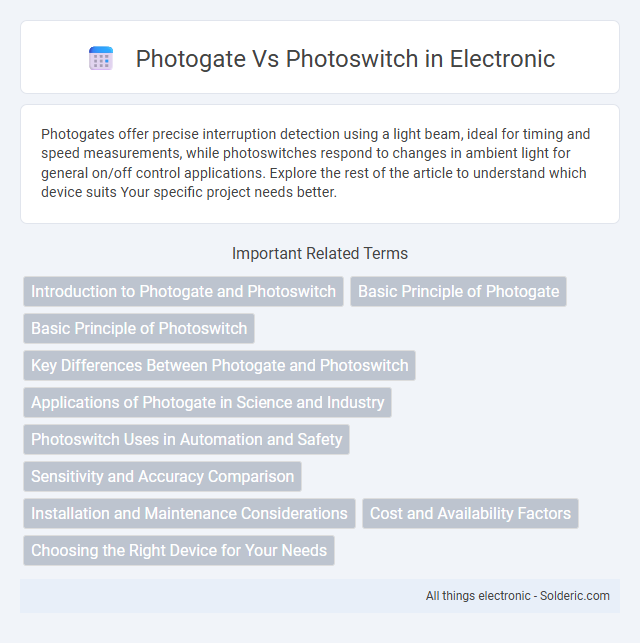Photogates offer precise interruption detection using a light beam, ideal for timing and speed measurements, while photoswitches respond to changes in ambient light for general on/off control applications. Explore the rest of the article to understand which device suits Your specific project needs better.
Comparison Table
| Feature | Photogate | Photoswitch |
|---|---|---|
| Function | Detects object interruption of a light beam | Detects ambient light level changes to switch circuits |
| Operation | Uses a light emitter and detector facing each other | Uses a photo-sensitive resistor or phototransistor |
| Application | Timing, speed measurement, object counting | Automatic lighting, alarm triggers, light-sensitive devices |
| Sensitivity | High sensitivity to beam interruption | Sensitivity varies with ambient light levels |
| Output | Digital pulse or signal on interruption | Switching action based on light intensity threshold |
| Setup | Requires precise alignment | Simple installation, no alignment needed |
| Cost | Generally higher due to precise components | Typically lower cost and simpler design |
Introduction to Photogate and Photoswitch
A photogate consists of an infrared emitter and detector aligned to detect interruptions in a light beam, enabling precise timing measurements in physics experiments. A photoswitch operates by changing its electrical conductivity in response to light intensity variations, typically used for automatic lighting control or safety devices. Both devices utilize light sensitivity but differ in function: photogates measure object movement, while photoswitches act as light-activated switches.
Basic Principle of Photogate
A photogate operates by detecting the interruption of a light beam between an emitter and a receiver, allowing precise measurement of object timing and speed. It relies on the principle that when an object passes through the gate, it blocks or unblocks the light path, triggering a sensor response. Photoswitches function similarly but often detect changes in ambient light intensity for on/off control rather than timing measurements.
Basic Principle of Photoswitch
A photoswitch operates by detecting changes in light intensity to open or close an electrical circuit, typically using semiconductor materials such as phototransistors or photodiodes. Unlike photogates, which measure interruptions of a light beam to determine timing or speed, photoswitches respond to variations in ambient or directed light to trigger control signals in automation systems. This basic principle makes photoswitches ideal for applications requiring light-triggered switching without precise object detection.
Key Differences Between Photogate and Photoswitch
Photogates use a beam of light interrupted by an object to accurately measure timing or speed, making them ideal for precise motion detection in experiments. Photoswitches rely on changes in light intensity to trigger an electrical switch, commonly used for simple automation tasks or light-activated control. The key difference lies in photogates providing precise, high-speed measurement capabilities, whereas photoswitches serve as binary on/off sensors responding to ambient light changes.
Applications of Photogate in Science and Industry
Photogates are widely utilized in physics experiments for measuring speed, acceleration, and timing with high precision, especially in kinematics and dynamics studies. In industrial automation, photogates serve as reliable sensors for object detection, counting, and positioning on assembly lines, enhancing efficiency and accuracy. Their non-contact operation and fast response time make photogates indispensable in robotics, CNC machines, and quality control systems for real-time monitoring and control.
Photoswitch Uses in Automation and Safety
Photoswitches are widely used in automation and safety systems due to their ability to detect presence or absence of objects with high precision. These devices enable real-time monitoring in manufacturing lines, triggering immediate responses to prevent accidents or halt machinery when an obstruction is detected. Your automation setup benefits from photoswitch integration by enhancing operational efficiency and ensuring workplace safety through reliable object detection.
Sensitivity and Accuracy Comparison
Photogates offer higher sensitivity and accuracy than photoswitches due to their ability to precisely detect interruptions in a focused light beam, making them ideal for timing and position measurement applications. Photoswitches, while simpler and more robust, generally provide less precise detection as they rely on ambient light changes, which can introduce variability. Your choice should consider the required measurement precision, with photogates preferred for tasks demanding fine temporal or spatial resolution.
Installation and Maintenance Considerations
Photogates require precise alignment during installation to ensure accurate interruption detection of the light beam, often necessitating stable mounting and clear line-of-sight. Photoswitches offer easier installation with flexible positioning, as they detect light presence or absence without strict alignment, reducing setup complexity. Maintenance for photogates involves regular cleaning of lenses and careful recalibration, while photoswitches generally need minimal upkeep due to their rugged design and tolerance for environmental variations.
Cost and Availability Factors
Photogates generally cost more than photoswitches due to their precise timing and detection capabilities, making them preferred in scientific experiments and educational settings. Photoswitches, often simpler in design, are widely available and more affordable, suitable for general automation and industrial applications. Both devices vary in availability depending on supplier specialization and regional market demand, with photoswitches commonly stocked in industrial component catalogs.
Choosing the Right Device for Your Needs
When choosing between a photogate and a photoswitch, consider the precision and application requirements, as photogates offer highly accurate object detection and timing, ideal for laboratory experiments and motion studies. Photoswitches provide simpler presence detection with less sensitivity to alignment, making them suitable for industrial automation and basic control systems. Your decision should prioritize the required detection accuracy, environmental conditions, and installation complexity to ensure optimal performance.
photogate vs photoswitch Infographic

 solderic.com
solderic.com